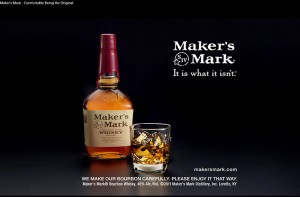It doesn’t get much more American than bourbon, and with a return to Americana palpable in pop culture, bourbon and American whiskey sales are up – as are production problems and marketing issues.
Interest in American whiskey has risen in pop culture through books like “Last Call: The Rise and Fall of Prohibition,” by Daniel Okrent, as well as in the documentary film “Prohibition,” by Ken Burns and Lynn Novick, and the HBO series “Boardwalk Empire” (Meece, 2011). Additionally, AMC’s hit show Mad Men has certainly played a part in re-branding your grandfather’s drink.
In the United States, “Most of the growth comes from an increase in flavored whiskeys in the past five years, which mirrors the increase in flavored vodka in prior years,” according to an interview with John Kristin “Kris” Sirchio, the Chief Marketing Officer of Brown-Forman, the parent company of Jack Daniel’s in Forbes. “The growth is also being fueled by small craft innovation” (Dan, 2012).
However, not only in U.S. markets, but internationally bourbon is seeing rising numbers; United States spirits exports grew 16.5% in 2011, reaching a record $1.34 billion, which beat out wine’s $1.14 billion and beer’s $334 million, according to data from the Distilled Spirits Council of the United States, a liquor trade group. Whiskey, including bourbon, accounts for 69% of spirits exports (Schultz, 2012). While the top export is Jack Daniels, which jumped to No. 19 on the Millionaires list from No. 21 last year, three other U.S. brands – Jim Beam, Maker’s Mark, and Wild Turkey – were among the fastest-growing whiskies in the world (Schultz, 2012).
In the midst of this bourbon boom, some distilleries are having trouble keeping up with market demands (Merwin, 2013). Recently, Maker’s Mark learned an interesting lesson in market research and backlash due to its shortage of product nationwide. In an effort to stretch its limited supply, Maker’s Mark announced in February it would reduce the alcohol by volume by 3% in an effort (Maker’s Mark, 2013). Backlash ensued on Facebook and other social media sites, as well as blogs, op-eds, and more. One week after its announcement, Maker’s Mark recanted in a statement on its website, stating, “effective immediately, we are reversing our decision to lower the ABV of Maker’s Mark, and resuming production at 45% alcohol by volume (90 proof). Just like we’ve made it since the very beginning” (Maker’s Mark, 2013). The tone of the release was personal and sincere. It began with “You spoke. We listened. Dear Friends, Since we announced our decision last week to reduce the alcohol content (ABV) of Maker’s Mark in response to supply constraints, we have heard many concerns and questions from our ambassadors and brand fans. We’re humbled by your overwhelming response and passion for Maker’s Mark. While we thought we were doing what’s right, this is your brand – and you told us in large numbers to change our decision. You spoke. We listened. And we’re sincerely sorry we let you down” (Maker’s Mark).
Maker’s Mark learned an important lesson in marketing this month. The company failed to conduct proper research and consider all stakeholders, and loyal fans of the product mostly felt cheated by the decision to “water down” (Merwin, 2013) the bourbon in an effort to stretch the limited supply. But, what could have easily been a brand disaster for the distillery turned into an interesting study in listening to customers and reversing a corporate decision, ultimately creating a week of media buzz for the bourbon brand.
By Hannah Martine
References:
Dan, Avi. (2012, July 5). When it comes to whiskey, America knows Jack. Forbes.
Retrieved from http://www.forbes.com/
Maker’s Mark (2013). You spoke. We listened [Press release]. Retrieved from
http://www.makersmark.com/#!/live-feed/news/34-you-spoke-we-listened
Meece, Mickey. (2011, December 24). Bourbon’s all-American uproar. The New York
Times. Retrieved from http://www.nytimes.com/
Merwin, Hugh. 2013, February 11). Maker’s Mark is watering down its bourbon. New
York Magazine. Retrieved from http://newyork.grubstreet.com/
Schultz, E.J. (2013, February 17). Maker’s reverses decision to lower alcohol content,
makes amends. Advertising Age. Retrieved from http://adage.com/
Schultz, E.J. (2013, February 6). Bourbon boom overseas fuels record spirits sales.
Advertising Age. Retrieved from http://adage.com/
Schultz, E.J. (2012, June 8). Global booze trends: winners, losers and how elections
spurred rum brand in Philippines. Advertising Age. Retrieved from http://adage.com/


14 Responses to Bourbon blunders: Maker’s Mark’s big branding mistake